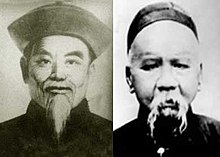 Wu Yuxiang (left), founder, and Hao Weizhen (right), third-generation grandmaster of Wu (Hao)-style tai chi | |
| Also known as | Kai He tai chi (開合太極拳) |
|---|---|
| Date founded | Mid-19th century |
| Country of origin | China |
| Founder | Wu Yuxiang |
| Arts taught | Tai chi |
| Ancestor arts | Yang-style tai chi, Chen-style tai chi |
| Descendant arts | Sun-style tai chi |
| Practitioners | 19th century:
|
| Wu (Hao)-style tai chi | |||||||||
|---|---|---|---|---|---|---|---|---|---|
| Traditional Chinese | 武郝式太極拳 | ||||||||
| Simplified Chinese | 武郝式太极拳 | ||||||||
| |||||||||
Wu (Hao)-style tai chi (Chinese: 武(郝)式太极拳; pinyin: Wǔ (Hǎo) shì tàijíquán) is one of the five primary styles of tai chi. It was created in the mid-nineteenth century by Wu Yuxiang, a member of a wealthy and influential family in Yongnian, Hebei, China. Wu trained for approximately ten years with the founder of Yang-style tai chi, and then for over a month with a Chen-style master. Wu also obtained a manual on internal martial arts that formed the core of what are now known as the tai chi classics and include Wu's own writing on the subject. From these sources Wu and his family developed their own style, and may also have developed much of the cultural and intellectual foundation of tai chi as well.[1][2][3]
Hao Weizhen was a disciple of Wu's nephew and was the first person outside the family to master their tai chi. Hao's contributions — in developing and spreading the art, and in training the founders of all subsequent Wu (Hao) lineages, as well as the further contributions of his son and grandson — are why many include his surname alongside or in place of Wu's when referring to this style.[4]
This Wu style (武, Wǔ) is the third-oldest among the five major styles – Chen, Yang, Wu (Hao), Wu (吳, Wú), and Sun – but is the smallest and least well-known of the five, in part because Wu Yuxiang and his family had no need to teach professionally. It is best known for its small- and medium-frame forms, as well as its emphasis on the core tai chi concept of "open-close" or "kai he" (開合, 开合), and so is also known as Kai He tai chi (開合太極拳).[5][6][7]